CIVIL
WAR SURGEON IMAGES
The De Gregoris
Alden
Image collection
Page: 1
The original source
of this private collection of Civil War CDV's is from Civil War surgeon, Charles
Henry Alden, Brigadier General, Medical Corps, U.S. Army
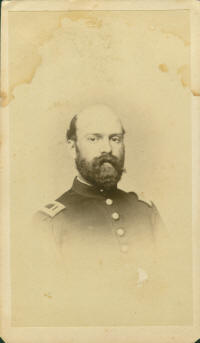
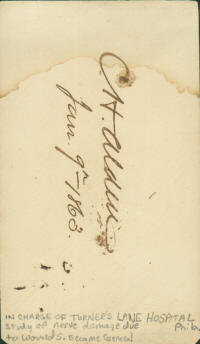
Charles Henry Alden, Brigadier General,
Medical Corps, U.S. Army
Charles Henry Alden (April 28, 1836-June 7, 1906), Brigadier General, Medical Corps, U. S. Army, was born in Philadelphia, Pennsylvania, the son of Reverend Charles H. Alden, a chaplain in the navy. He was educated at Brown University where he received the degree of A. M. in 1856 and at Pennsylvania Medical College, Philadelphia, medical department of Pennsylvania College of Gettysburg, where he graduated in 1858. In April 1859 he passed the examination for the medical corps of the army and was immediately employed as a contract surgeon and ordered to accompany recruits to Fort Defiance, N. M., where he participated in a campaign against Navajo Indians. On June 23, 1860, he was commissioned an assistant surgeon. During the next year he served at five different stations in New Mexico. Following the outbreak of the Civil War he was captured together with the greater part of the 7th Infantry on July 27, 1861, at San Augustine Springs, N. M., by a force of Confederates. He was paroled and for the next year served at camps of prisoners of war at Fort Leavenworth, Jefferson Barracks, and Rouse’s Point, N. Y. In July 1862 he was ordered to Washington, where he organized the Georgetown College Hospital. In October, his parole having expired, he was attached to the office of the medical director of the Army of the Potomac, in which capacity he had charge of the evacuation of the wounded of the battle of Fredericksburg in December from Falmouth to Acquia Creek. In April 1863 he was transferred to Philadelphia and placed in charge of Turner’s Lane General Hospital and made recorder of the Army Medical Examining Board. His service in Philadelphia was varied by inspection duty incident to the draft and duty in the offices of medical director and the medical purveyor of the Department of Pennsylvania. He was given the brevets of major and lieutenant colonel on March 13, 1865, for “faithful and meritorious service” and on June 23, 1865, was advanced to the grade of captain in the regular corps, and to the grade of major on July 28, 1866. In May 1867 he was transferred to duty with the 30th Infantry, which was engaged in the protection of the builders of the Union Pacific railroad in Wyoming. He was on this duty and at Fort D. A. Russell, Wyoming, for three years, following which he served at Fort Gratiot, Mich. (1870-72), Fort Porter, N. Y. (1872-73), Fort Walla Walla, Wash. (1873-76), and Fort Townsend, Wash. (1876-77). In the meantime he spent four months’ leave in the surgical clinics of Europe in 1873 and participated in field duty in Wallowa Valley, Oregon, in 1875 and in the campaign in Idaho in 1877 against the Nez Perce Indians, where he took part in the engagement on the Clearwater and that at Kamiah.
He was ordered to New York City in November 1877 for duty as recorder of the Army Medical Examining Board in which capacity he served for five years until transferred to Fort Yates, Dakota, in 1882. From here, after two years, he was sent to Fort Snelling, Minnesota, where he acted as post surgeon and as attending surgeon at the headquarters of the Department of Dakota.
From the beginning of his army career he interested himself in operative surgery and in the natural history of the section in which he was stationed. He contributed
Reports on surgical cases to the surgical section of the Medical and Surgical History of the War of the Rebellion and a
Report on prison depot, Fort Delaware, to the medical section. A report upon the climate of Fort D. A. Russell together with its flora and fauna was issued as a circular from the office of The Surgeon General in 1870 as was also a similar report on Fort Walla Walla in 1875. A report of surgical cases in 1871 was made the subject of a circular from the same source (S.G.O. Cir. No. 3, August 17, 1871). He was an early convert to antiseptic surgery and reported his experiences in that field in the annual
Report of The Surgeon General of that period.
After three years at Fort Snelling Major Alden was transferred to duty at the United States Military Academy at West Point in 1887, with additional duty as president of the Army Medical Examining Board in New York. On his recommendation in 1888 a change was made in the procedure of the board by which it met periodically for examination of classes of candidates instead of examining them singly as they presented themselves.
In 1891 Alden, a lieutenant colonel since Nov. 14, 1888, was transferred to St. Paul, Minnesota, as medical director of the Department of Dakota. In that year he was active in the organization of the Association of Military Surgeons of the National Guard in Chicago. Though not eligible for active membership, he was a member of the committee which drew up its constitution and by-laws. He was one of five members of the regular corps elected to honorary membership at this meeting, others being Lieut. Colonel J. B. L. Irwin and Major A. C. Girard. At the 1894 convention of this society at Washington he presented a paper on the Special training of the medical officer.
In August 1892 Colonel Alden was ordered to Washington for duty in the office of The Surgeon General and placed in charge of the Hospital Corps and the division of supply. He performed the exacting duties of these positions with credit during the Spanish-American War. On December 4, 1892, he had reached the grade of colonel. During his later years of service he was General Sternberg’s first assistant and was frequently in charge of the office during the absence of his chief. He was one of the first advocates of a special medical school for the army and when authority for the Army Medical School was obtained in 1893 he was the first president of its faculty and lecturer on the duties of medical officers. He is credited with the recommendation which resulted in the issuance of Circular No. 9 from the Headquarters of the Army, A.G.O., September 9, 1895, authorizing operation upon soldiers subject to hernia instead of their discharge from the service. In 1896 he was a delegate to the Pan-American Medical Congress in Mexico City and in 1899 was official delegate to the Association of Military Surgeons meeting in Kansas City, where he was elected president of the society. During the greater part of his Washington service he was again the president of the board for examination of candidates for the corps. By repeated service on this board he exercised more influence upon the membership of the corps than any man since the retirement of Surgeon Thomas G. Mower.
Colonel Alden reached the statutory age for retirement on April 28, 1900, and took up his residence in Newtonville, Mass. In 1901 the University of Pennsylvania conferred upon him the degree of Doctor of Medicine, honoris causa, an honor bestowed but a few times since it was originated to honor French medical officers serving in the Revolutionary army. On April 23, 1904, he was advanced to the grade of brigadier general on the retired list.
Ill health compelled him to migrate to California and take residence at Pasadena where he died of pulmonary tuberculosis at the age of seventy years. His body was cremated and his ashes sent to Arlington Cemetery for interment.
Colonel Alden was a joiner of societies, medical, scientific, scholastic, and patriotic. To single out a few, he was a member of the Loyal Legion, the Massachusetts Society of Mayflower Descendents, the Old Colony Historical Society, the Order of Indian Wars, the National Society for the Study and Prevention of Tuberculosis, and the American Climatological Association. To the transactions of this latter society he contributed a paper on
Climatology of Porto Rico and Some Southern California health resorts. He was a member of the Episcopal Church and interested himself in the affairs of the church wherever he was stationed. He was particularly interested in the mission work in the western part of the country.
He was a genial, whole-souled man, sociable and popular. His portrait, taken in later life, shows strong, clear-cut features, a fringe of white hair and large, square-cut, parted whiskers, with the flowing moustache so much in vogue at the time.
He was married at Philadelphia on October 22, 1864, to Katherine Russell Lincoln of that city, who with two sons and a daughter survived him. A son, Eliot, followed his father in the medical profession and is now a practitioner in Los Angeles California.
(J. A. M. A., 1906, XLVI.
Military Surgeon, 1907, XX.
Trans. Am. Climat. Assn., 1907, XXIII. Alumni Register, U. of Pa., 1905-06.
Records of Living Officers of the U. S. Army, L. R. Hamersly, Phila., 1884.
Annual Report of The Surgeon General, 1896, p. 97.)
James M. Phalen,
Colonel, U. S. Army, Retired.
______________
Research note: The fact
so few of the surgeons in this collection are found in the 'Roster' of
Regimental Surgeons' or in the American Medical Association data base is
telling in regard to the relative little value of those two references for
finding all physicians who served during the Civil War in uniform.
This group of surgeon CDV's contains many older surgeons who were in the
Army prior to and during the Civil War and many who were in the Army Medical
Corps.
At the opening of hostilities
between the States the personnel of the Medical Department of the regular
army was composed of one surgeon-general with the rank of colonel, thirty
surgeons with the rank of major, and eighty-four assistant surgeons with the
rank of first lieutenant for the first five years of service, and thereafter
with the rank of captain, until promoted to the grade of major.
The Medical Department, with the
above personnel, formed one of the coordinate branches of the general staff
of the army as it existed in 1861. Its members were not permanently attached
to any regiment or command, but their services were utilized whenever
required. Although a separate regimental medical service still existed in
many foreign armies, as it did in our militia, experience had demonstrated
that our national system of a separate department was better adapted to the
needs of troops when scattered over an immense area, and usually serving in
small and isolated commands. The latter requirements explained the unusually
large proportion of surgeons necessary at the time, amounting to about one
percent of the total strength.
This little force of one hundred and fifteen
trained medical officers theoretically available at the beginning of the war
was, however, materially depleted. Many of its members were of Southern
birth and sympathy, and no less than twenty-seven resigned from the army at
the outbreak of hostilities. Three who so resigned entered into the practice
of their profession, declining to assist either against their Southern
kindred or their friends in the Northern States and former military
associates remaining under the old flag. But the remaining twenty-four
merely transferred their services to the military forces of the Confederacy,
where they were promptly given the positions of responsibility and power
which their previous experience and training warranted. These men formed the
nucleus about which the Medical Department of the Confederacy was created,
building it up along the administrative lines to which they were accustomed,
and even adopting the same blank forms and reports, as, for example, that
for the sick and wounded, which they had formerly used in the Federal
service. In many particulars the organization was identical.
The Northern medical services were organized into seven
categories:
1.
Surgeons and Assistant Surgeons of the
United States Army. This was
the regular Medical Corps and consisted of men in the service when the war
began. The War began with only 90 medical officers, but was
drastically expanded as the war commenced.
2.
Surgeons and Assistant Surgeons of
Volunteers. These were
former "brigade surgeons" created by Congress to supplement the work of the
regular staff surgeons. A total of 547 commissions were issued.
3.
Regimental Surgeons
and Assistant Surgeons, commissioned by state governors rather than congress
or the President. There were 2,109 Surgeons and 3,882 Assistant
Surgeons. (Note: these are some of the best documented surgeons and a list of
their names is found in the "List of Battles and Roster of Regimental
Surgeons", but the list is by no means complete for the Union
surgeons.
4.
Acting Assistant Surgeons, United States
Army. These physicians were known as the 'contract' surgeons.
They held no commission but received pay as first lieutenants. There
were a total of 5,532 Acting Assistant Surgeons; most of which worked in the
general hospitals in the North. They also continued their civilian
practice at the same time. (Note: of all the so called "Civil War"
surgeons, this group is the most difficult to identify. Without
personal correspondence or other documents, it is very difficult to pinpoint
any contract surgeon as being a 'Civil War' surgeon.
5.
Medical officers of the Veterans Corps.
6.
Acting Staff Surgeons.
7.
Surgeons and Assistant Surgeons of the
Colored Troops, who received
presidential commissions. They were assigned to the Black troops
This
collection of CDV's has NOT been fully researched yet and there ARE
errors and omissions. Any help in supplying information or sources on the
individuals would be greatly appreciated.
If
you have any Civil War images for sale, north or south, please
contact us as we are constantly adding to this collection.
Search DeGregoris Index by:
Page: 1
(Click on all images to
enlarge)
Finley, Clement Alexander
Ohio, Ohio
Surgeon's mate 1st. Infantry, 10 Aug 1
1818; Surgeon 1 June 1821; Maj Surg 13 July 1832; Col Surg
General 15 May 1861; retired 14 Apr 1862; Bvt Brig Gen 13 Mar
1865 for long and ser in the army granted the pay of gen retd
from 10 July 1876; died 8 1879
Clement Alexander Finley was born
on May 11, 1797 in Newville, Pennsylvania. His family moved very
soon after to Chillicothe, Ohio when his father, a cavalry hero
of the Revolutionary War, received a sizable plot of land for
his war service. Young Clement was educated in local schools and
then returned to Cumberland County to enroll at Dickinson
College with the Class of 1815. He graduated with his
class and then studied medicine at the University of
Pennsylvania, receiving his M.D. in 1818. That August, he
entered the United States Army's First Infantry as a surgeon's
mate.
Service in this regiment took him to Louisiana and Arkansas,
first at Fort Smith and then at Fort Gibson, and later to
Florida, Missouri, and Fort Leavenworth, Kansas. After more
garrison duty at Fort Dearborn in Illinois and Fort Howard in
Wisconsin, he was assigned as chief medical officer for the
operations in the Black Hawk War of 1833 and saw campaigning
again during the years of the Seminole War. Peace in 1838
brought him back to garrisons in Virginia and New York, as well
as a four year assignment "at home" at the Carlisle Barracks.
During the Mexican War, he served as medical director for
General Zachary Taylor in Texas and then for General Winfield
Scott in the Mexico City campaign. His work on both these
assignments was curtailed by illness.
In May 1861 President Abraham Lincoln appointed Finley, the
senior medical officer of the Army, to the post of Surgeon
General. He immediately engaged in expanding the medical service
and selecting sites for new hospitals needed during the Civil
War. In April 1862, however, he argued so heatedly with
Secretary of War Stanton over appointments that he was removed
from his position and was told to prepare for another
assignment. He retired from the Army soon after at the age of
65. In 1865, Finley was rewarded for his long service with the
breveted rank of brigadier general,
More on Finley |
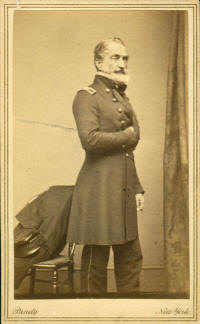 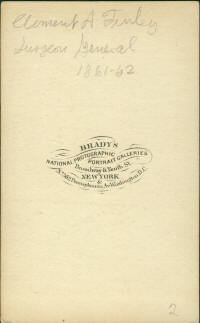 |
|
Satterlee. Richard Smith
N Y, Mich
Asst Surg 25 Feb 1822; Major Surg
13 Julv 1832; It col chief medical purveyor 28 Julv 1866;
retured 22 Feb 1869 ;bvt It col col and brig gen 2 Sept 18 54
for diligent care ami attention in procuring proper army
supplies as med purveyor and for economy and fidelity in the
disbursement of large sums of money died 10 Nov 1880
Richard Smith Satterlee (1798-1880)
Born at Fairfield, N.Y., he was the son of Major William
Satterlee, who fought in the War of 1812. Richard was
commissioned into the U.S. Army, on Feb. 25, 1822, as assistant
surgeon, on the recommendation of Governor Lewis Cass, and
served for the next 15 years on frontier army posts. In 1837, he
was appointed Medical Director, in the command of General
Zachary Taylor, in Florida. After the battle of Okeechobee, he
served under General Winfield Scott. Appointed Chief Surgeon,
1st Division, U.S. Army, in 1847, under General Worth, he served
at the Mexican War battles of Vera Cruz, Cerro Gordo,
Churubusco, Molino del Rey, and at the storming of Chapultepec,
and Mexico City, and he remained in Mexico as Medical Director
during the occupation. He was onboard the steamer, "San
Francisco" when she wrecked off Cape Hatteras in December 1852.
Afterwards, he was brevetted colonel, and appointed Chief
Medical Purveyor, with headquarters in New York. He was promoted
to brevet brigadier general, Sept. 2, 1864, for diligent care
and attention in procuring proper army supplies as the Medical
Purveyor, and for economy and fidelity in the disbursements of
over 20 million dollars. He retired from the U.S. Army in 1869.
More on Satterlee |
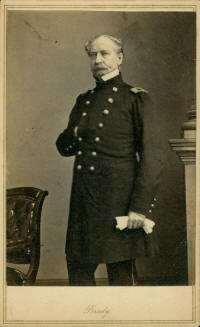 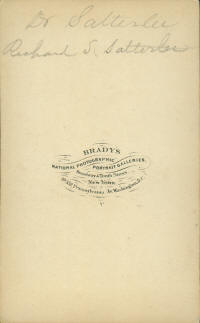 |
AD 1a
Josiah Simpson, Baltimore, Sept. 4, 1863
NJ, Pa,
Asst Surg 11 July 1837; Major
Surg 12 Aug 1855 ;Bvt. Lt. Col. and Col. 13 Mar. 1865 for
fai and mer service during the war; died 3 Mar 1874.
Not in Roster or
AMA
|
 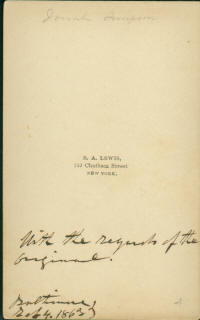 |
AD 1b
Thomas Chalmers Brainerd, Asst. Surgeon, U.S. Army
Pa, Pa,
Asst Surg 5 Aug 1861; Bvt Capt and
Major 13 Mar 1865 for fai and mer ser dur the war resigned
28 May 1866
Not in Roster
or AMA
|
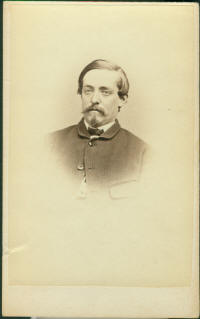 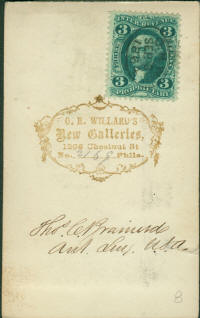 |
AD 1c
Charles Carroll Lee, Jan. 9th,
1863
Asst. Surgeon, 1st.
Maryland Cav. Oct. 1861, Hon. discharged Mar. 1862. U.
S. Army Asst. Surgeon May 1862, Brev. Capt. & Maj. 1865. Died 1893
AMA data:
Name: Charles Carroll Lee
Death date: May 11, 1893
Place of death: New York, NY
Type of practice: Allopath
|
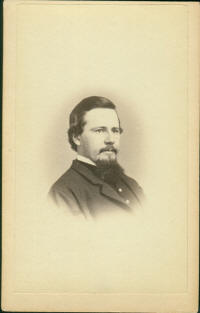 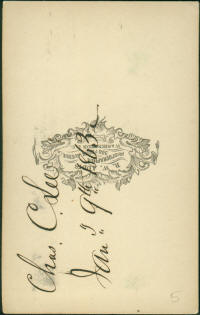 |
AD 1d
Hospital Steward at Ft. D.
A. Russell, 1869
Fort D. A. Russell was
located in Wyoming. Unidentified Steward |
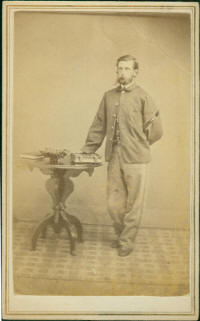 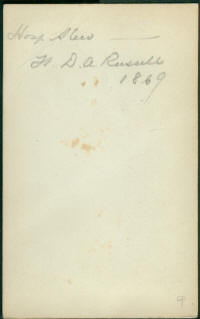 |
AD 1e
I. F. Machaus, (sp?)
Bvt. Ltd. Col. Surgeon, U.S.A.
Name
is illeg., unidentified
|
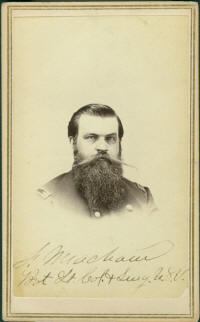 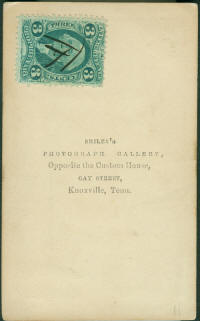 |
AD 1f
B. J. D. Irwin, U.S.A.
Bernard John Dowling Irwin, U.S.A.
Ireland, N.Y.,
Asst. Surg. Aug, 1858;
Maj. Surgeon Sept. 1862; Lt. Col. Surg. Asst. medical purveyor, Sept.
1885; Col. Surgeon; Aug. 1890; Brev. Col.; Metal of Honor 1894
AMA data
Name: B. J. D. Irwin
Death date: Dec 31, 1929?
Type of practice: Allopath
States and years of licenses: IL
More on
Irwin
|
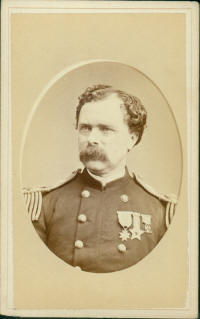 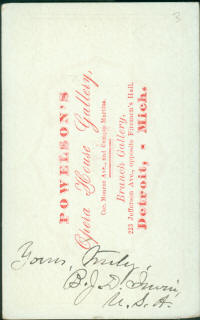
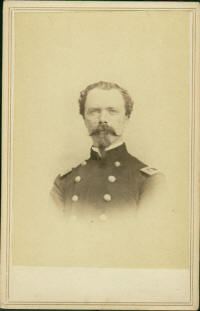 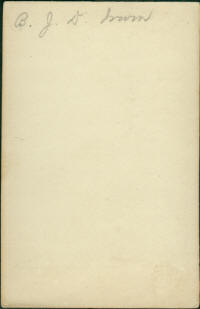 |
AD 1g
Robert Murray, Surgeon General, Inscribed to C. H. Alden
Md, Md,
Asst Surg 29 June 1846; Maj Surg 23 June 1860;
Lt Col Asst Medical Purveyor, 28 Julv 1866; Col Surg 26 June 1876;
Col Asst. Surg. General, 14 Dec 1882; Brig General Surg. General 23 Nov
1883; retd 6 Aug 1886; Bvt lt col and col 13 Mar 1865 for fai and mer
ser during the war
Not in Roster or AMA
In September 1861 he was ordered to the field and
successively employed during the years 1861 and 1862 as Medical Director
and Medical Purveyor with the commands of Generals
Robert
Anderson, William Tecumseh Sherman, Don Carlos Buell and W. S.
Rosecrans in Kentucky, Tennessee, Mississippi and Alabama. During this
period he carried an especially heavy load of responsibility, being
widely separated from the sources of supply and with the aid mainly of
inexperienced medical officers. |
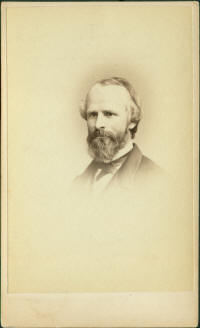 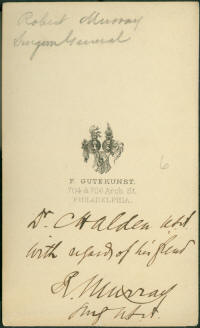 |
AD 1h
Charles Aarchibald McCall,
Assistant Surgeon, U.S.A, Washington, D.C., Jan. 10, 1863
Asst. Surg. Aug. 1861, Bvt.
Capt. and Major, March 1865.
AMA data:
Name: Charles Archibald McCall
Cause of death: influenza
Death date: Mar 1903
Place of death: West Philadelphia, PA
Birth date: 1838
Type of practice: Allopath
States and years of licenses:PA, 1881
Hospital affiliations: Mount Pleasant Hospital
Medical school(s): University of Pennsylvania School of Medicine,
Philadelphia, 1858, (G) |
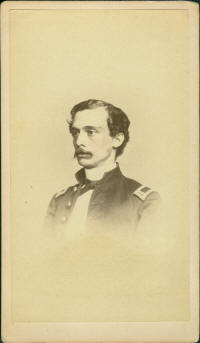 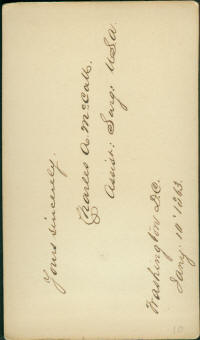 |
AD 1i
Francis Laban Town, U.S.A.
New Hampshire; Pa.
Asst. Surgeon May 1861; Major
Surgeon May 1866; Lt. Col. Surg. July 1889; Col. Asst. Surg. General,
1894. Retired 1896.
Roster: U. S. Volunteer Infantry,
Asst. Surgeon, Care A. G. U.S.A., 4th Infantry, mustered out June,
1866.
Not in AMA |
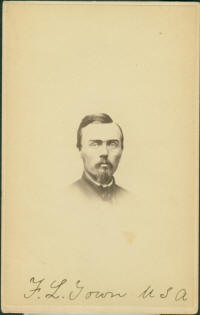 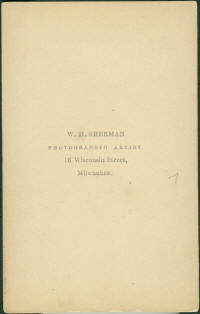 |
AD 1j
Van Buren Hubbard
Ohio, Ohio
Asst. Surg. July 1862; Major
Surg. Aug. 1881, died 1895
AMA data:
Name: Van Buren Hubbard
Death date: Sep 1895
Place of death: Ft. McPherson, GA
Type of practice: Allopath |
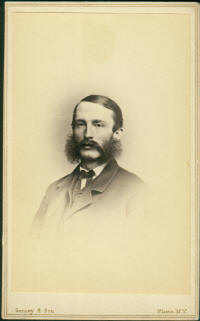 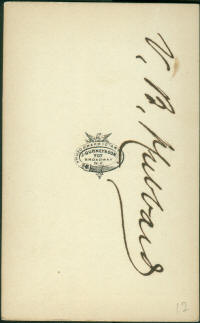 |
Continue via:
|
1 |
2 |
3 |
4 |
5 |
6 |
7 |
8
|
Search DeGregoris Index by:
Written permission is required for use of any image in any form
of publication. Sale or reproduction of any image is strictly prohibited.
|
|